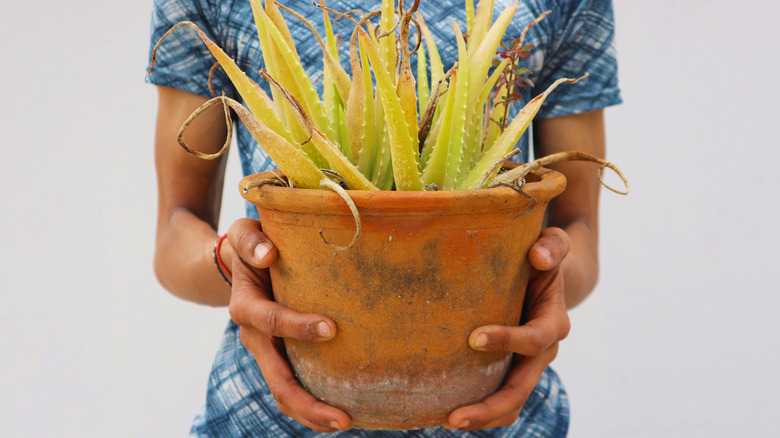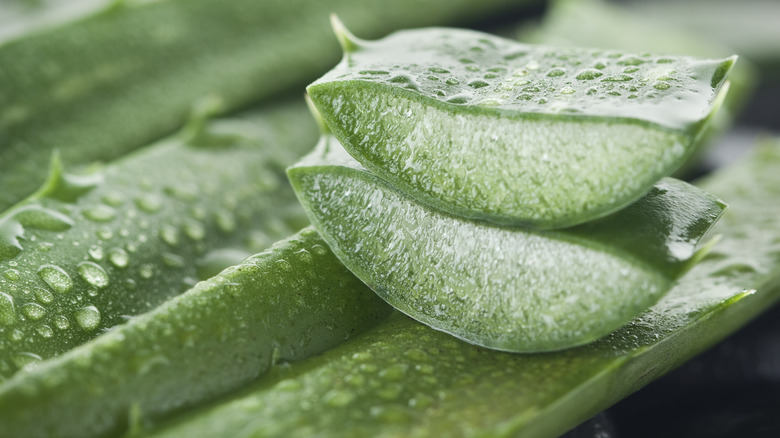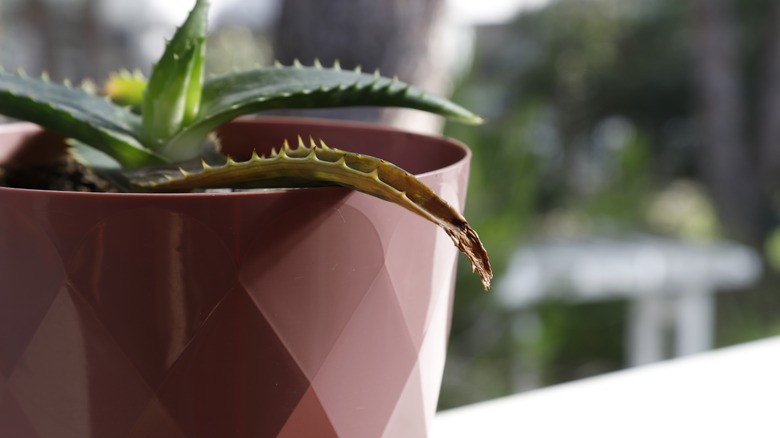What Your Aloe Plant's Yellow Leaves Are Trying To Tell You
Some say that a home is not complete without plants. Even if you have laid every brick, finished the basement, and painted every room by hand, you may still feel like your home is missing something if you do not have a pot full of fresh plants somewhere. For many homeowners, becoming a plant parent is a rite of passage upon moving into their humble abode. And one of the most popular homegrown plant options? Aloe vera!
Aloe vera is a succulent plant that is beloved by many for its innumerable medicinal benefits. It grows perennially in a cluster of long, thick stalks, and when aloe vera is harvested properly, it can prove very rewarding. When plucked and cut open, one will find that these stalks hold an encasement of clear gel, which can be used for everything from skincare, to burn treatment, and so much more. But how can one be sure that their aloe vera plant is healthy, thriving, and safe for usage? Well, the leaves will tell it all. Here's what the color of your aloe vera's leaves can signify.
How healthy aloe vera should look
Like most other plants, one should be able to gauge the health of an aloe vera plant by its external characteristics. A healthy and well-maintained aloe vera plant should have a multitude of thick, strong stalks. The plant should be a bright, grassy green color, and each stalk should point upward to the sky and feel firm to the touch. Upon plucking a stalk, you should find a generous amount of thick, sticky aloe vera gel inside. If your aloe vera plant checks all of these boxes, then you can rest assured that your plant is in tip-top shape.
Alternatively, an unhealthy aloe vera plant is going to look vastly different. It will begin to yellow, and this process typically starts at the tips of the stalk and then gradually takes over the entirety of the plant. Upon yellowing, the stalks will become very weak and fragile, beginning to sag, droop, and then fall off if the problem goes unchecked.
How to solve yellowing leaves
There are several catalysts behind yellowing leaves: overwatering, dehydration, excessive sunlight, and under-fertilization.
Overwatering means the plant has received excessive water. Excessive amounts of water reduce oxygen in the soil. When there isn't enough oxygen in the soil, the plant's roots become damaged and incapable of absorbing water. Dehydration is the exact opposite, occurring when a plant has not received sufficient water. There's a fine line between overwatering and underwatering, making this tricky practice one of the most common mistakes among plant owners.
Excessive sunlight means the plant has spent too much time in sunlight. This triggers a breakdown of the plant's chlorophyll, causing the plant to lose pigmentation and begin yellowing. Similarly, under-fertilization occurs when a plant's soil lacks the nutrients necessary for the plant's growth. These practices will prove detrimental to not only aloe vera plants, but any plant.
So, what can one do to solve this saggy yellow leaves problem? Well, once a leaf has begun to yellow, it's incapable of "greening" again, so it's best to pluck the yellow stalks. Then, consider your watering habits — should you reduce or increase? From there, consider the time that the plant spends in sunlight. If the plant is indoors, try moving it further away from the window or moving it to a shady area periodically throughout the day. Finally, gauge the fertilization levels of your plant and consider adding more to the soil if necessary.


